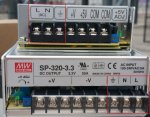QWTLNW
Member
- Location
- Fort Worth
Does the primary of a modern day switching power supply care if the voltage is line to line or line to neutral ?
See attachment. Line clearly marked "L-N-G". And in the data sheets it only refers to Line-Neutral voltages.
I figured that the 100-240V rating simply made it "worldwide compatible" w/ typical worldwide PH-N voltages.
But now I have been told by several people that modern switching power supplies don't care if the voltage is line to neutral or line to line. If using line to line just connect the 2nd hot leg to the lug marked for the neutral.
Can't find any decent internal wiring diagrams for these units to review.
Any input or help is deeply appreciated. (designing service and distribution for a sign that has 258 of these little demons)
See attachment. Line clearly marked "L-N-G". And in the data sheets it only refers to Line-Neutral voltages.
I figured that the 100-240V rating simply made it "worldwide compatible" w/ typical worldwide PH-N voltages.
But now I have been told by several people that modern switching power supplies don't care if the voltage is line to neutral or line to line. If using line to line just connect the 2nd hot leg to the lug marked for the neutral.
Can't find any decent internal wiring diagrams for these units to review.
Any input or help is deeply appreciated. (designing service and distribution for a sign that has 258 of these little demons)


